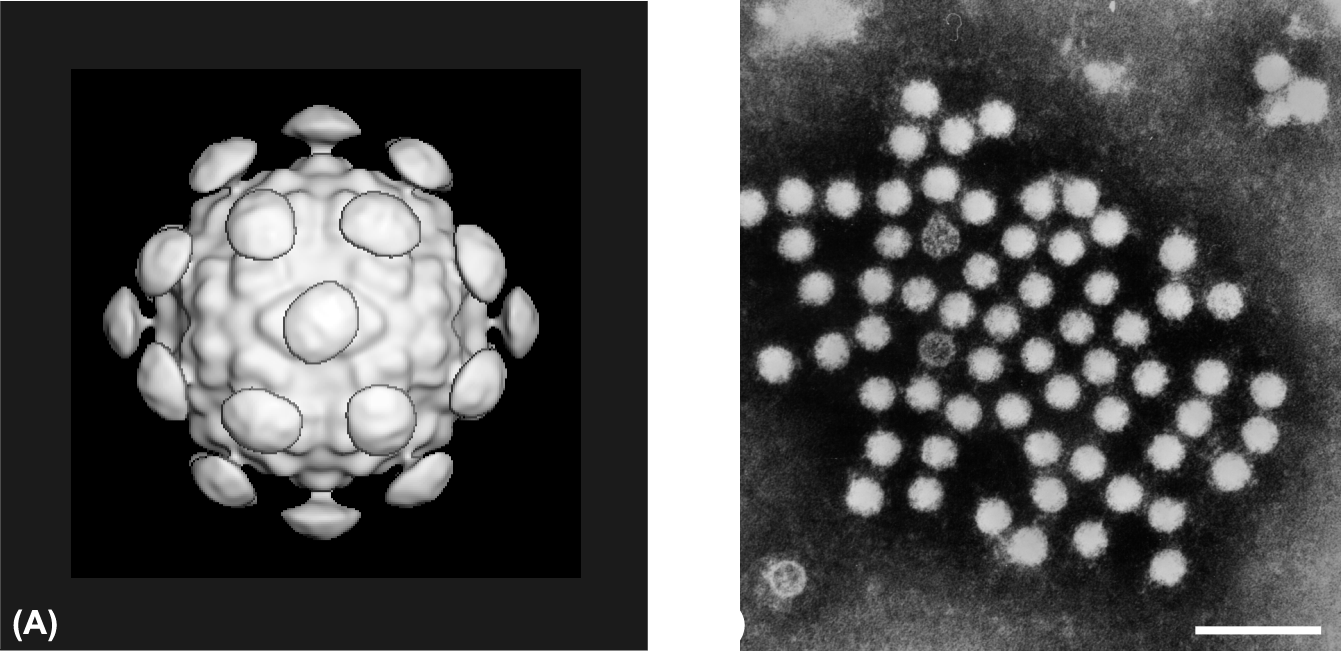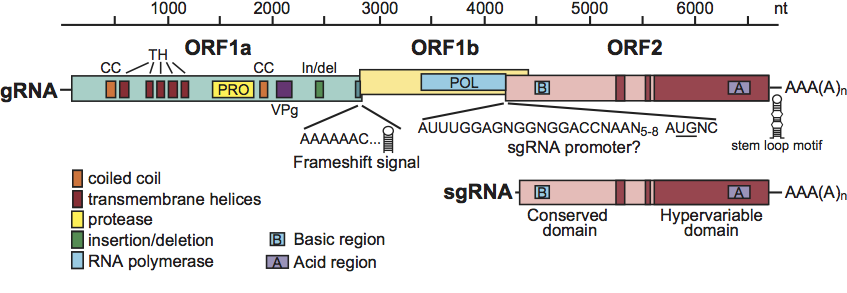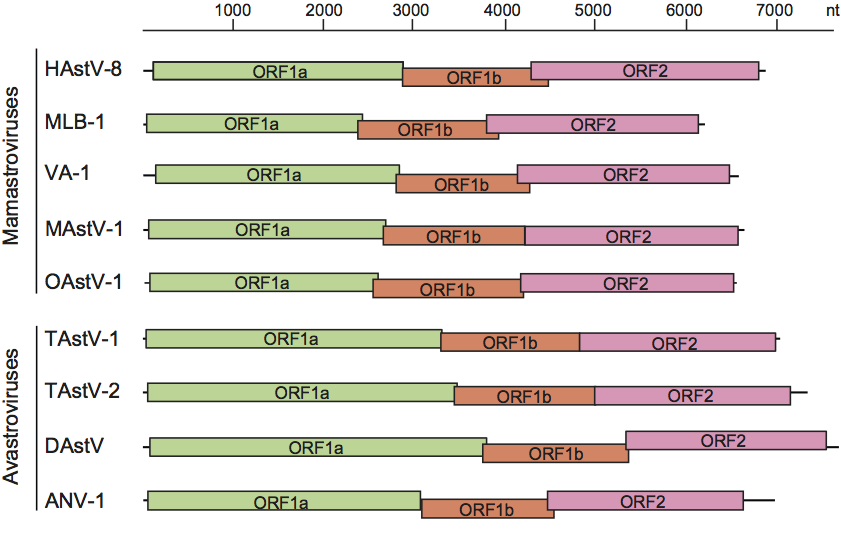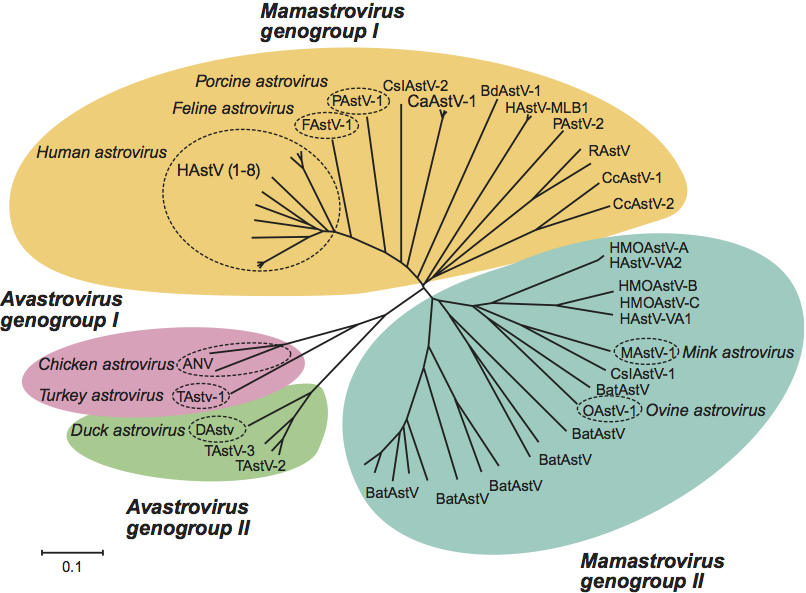Family: Astroviridae
Chapter Version: ICTV Ninth Report; 2009 Taxonomy Release
Virion properties
Morphology
Virions shed in feces are 28–30 nm in diameter, spherical in shape and non-enveloped. A distinctive five- or six-pointed star is discernible on the surface of about 10% of virions. Virions derived from cell culture are up to 41 nm in diameter, with well-defined surface spikes (Figure 1).
Physicochemical and physical properties
Virion Mr is about 8×106, S20,w is about 160S. Virion buoyant density in CsCl is 1.35–1.39 g cm−3. Virions are resistant to pH 3, heating at 50 °C for 1 h or 60 °C for 5 min, chloroform, lipid solvents and non-ionic, anionic, and zwitterionic detergents.
Nucleic acid
Virions contain one molecule of infectious, positive sense, ssRNA, 6.4–7.7 kb in size. A poly(A) tract is located after the 3′-NTR. The structure of the 5′ end of the genome is not known. A small protein with similarity to calicivirus and picornavirus VPg has been identified by sequence comparisons. No RNA helicase domain has been described. Eighteen to twenty nucleotides preceding the ORF2 initiation codon are highly conserved among most astroviruses. The lengths of the NTRs at both ends of the genome vary by genus, between 11–85 and 59–305 at 5′ and 3′ ends, respectively.
Proteins
In human astroviruses, intracellular particles are formed from the 87–90 kDa primary polyprotein product of ORF2. Purified particles and extracellular virions of HAstV-8 are assembled from a 70 kDa protein species that results from intracellular processing of the carboxy-terminal region of the 87–90 kDa protein by caspases. Particles composed of the 70 kDa protein are cleaved extracellularly by trypsin through a complex pathway resulting in highly-infectious particles with capsid proteins of 32–34, 27–29 and 25–26 kDa. In most other astroviruses, virion protein composition has not been established, and usually consists of three mature capsid species ranging between 24 and 39 kDa.
Lipids
Virions do not contain a lipid envelope.
Carbohydrates
None of the viral proteins are glycosylated.
Genome organization and replication
The astrovirus genome is arranged in three ORFs: ORF1a and ORF1b at the 5′ end encoding the non-structural proteins, and ORF2 at the 3′ end encoding the structural proteins (Figures 2 and 3). The virion RNA is infectious and serves as a messenger RNA for the non-structural polyproteins, nsp1a and nsp1ab. A frame-shifting mechanism located between ORF1a and ORF1b is employed to translate the RNA-dependent RNA polymerase. A polyadenylated, sgRNA (ca. 2.8 kb) corresponding to ORF2 is detected in the cytoplasm of infected cells. Viral RNA replication is resistant to actinomycin D. For the best characterized human astroviruses, a full-length capsid polyprotein resulting from expression of ORF2 from the sgRNA forms particles in the cytoplasm of infected cells. Extracellular particles exposed to trypsin form three major capsid proteins with enhanced infectivity. There is evidence that astroviruses can undergo recombination.
Antigenic properties
Eight serotypes of the classical human astroviruses (HAstV) have been defined by immune electron microscopy and neutralization tests and have been confirmed by sequence comparisons, mainly of the carboxy-terminal hypervariable domain of the structural protein encoded by ORF2. They share at least one common epitope recognized by a monoclonal antibody localized at the conserved amino-terminal domain. Neutralization epitopes have been mapped to the 26 and 29 kDa capsid proteins of HAstV-1 and HAstV-2. Two distinct serotypes of bovine astrovirus, two of turkey astrovirus 2 (TAstV-2), two of avian nephritis virus (ANV) and two of chicken astrovirus (CAstV) have been defined by neutralization. Since 2008, several novel human astroviruses have been identified (MLB1 and MLB2; VA1, VA2, and VA3; HMO-A, HMO-B and HMO-C), but there is little information on the antigenic properties of these strains.
Biological properties
Astroviruses have been isolated from stools from a wide variety of mammals and birds (humans, cats, cattle, deer, dogs, ducks, mice, pigs, sheep, mink, turkeys, chickens, bats, cheetahs, guinea fowl, rats and marine mammals), mostly associated with gastroenteritis in young individuals. Besides enteric disease, astrovirus infections have been associated with fatal hepatitis in ducks, and interstitial nephritis causing growth retardation in young chicken. Transmission is by the fecal–oral route and no intermediate vectors have been described. Astrovirus pathogenesis appears to vary by genus. It has been shown in cell monolayers that astrovirus-induced permeability occurs independently of viral replication and is modulated by the capsid protein. Certain strains of HAstV induce an apoptotic response and activation of caspases, whose activity is required for processing of the capsid precursor, and for virus release. HAstV-1 capsid protein has also been demonstrated to bind complement proteins C1q and MBL thus inhibiting activation of the classical and lectin pathways of the human complement system, respectively.
Genus Avastrovirus
Type species Turkey astrovirus
Distinguishing features
Members of the genus Avastrovirus infect birds.
Biological properties
Infection with Avastrovirus species often involves extra-intestinal manifestations (e.g. damage to liver, kidney, or the immune system). Duck astrovirus (DAstV) causes an often-fatal hepatitis in ducklings. Astroviruses infecting turkeys (TAstV-1, TAstV-2 and ANV), guinea fowl (TAstV-2) and chickens (ANV and CAstV) affect multiple organs, including the kidney and thymus.
Duck astrovirus grows in embryonated hens’ eggs following blind passage in the amniotic sac. Few infected embryos die in less than 7 days. Infected embryos appear stunted and have greenish, necrotic livers in which astrovirus particles have been identified. Certain strains of chicken astrovirus grow in LMH cells. The turkey astroviruses grow in embryonated turkey eggs following passage in the amniotic sac. Few infected embryos die. Infected embryos range from no signs of infection to severely enlarged, distended and fluid-filled intestines. Both the intestinal tissue and fluid contain infectious viral particles.
Species demarcation criteria in the genus
The current avastrovirus species are based on the hosts from which they were isolated. As such, the species do not correspond to genetic phylogenies. The classification of avastrovirus species is currently being redefined. Based on genetic analysis of the complete capsid region at the amino acid level, avian astroviruses will be divided into two main genogroups: genogroup I and genogroup II. Each genogroup includes astroviruses infecting different host species, and can be further subdivided into genotype species based on both genetic and host species criteria. Mean amino acid genetic distances (p-dist) between the two genogroups is 0.704±0.013. Within each genogroup, amino acid genetic distances between genotypes range between 0.576 and 0.741.
List of species in the genus Avastrovirus
| Chicken astrovirus |
|
|
| Avian nephritis virus 1 | [AB033998] | (ANV-1) |
| Avian nephritis virus 2 | [AB046864*] | (ANV-2) |
| Avian nephritis virus 3 | [FJ940720*] | (ANV-3) |
| Duck astrovirus |
|
|
| Duck astrovirus C-NGB | [FJ434664] | (DAstV-C-NGB) |
| Turkey astrovirus |
|
|
| Turkey astrovirus 1 | [Y15936] | (TAstV-1) |
Species names are in italic script; names of isolates are in roman script. Sequence accessions [ ], and assigned abbreviations ( ) are also listed.
* Sequences do not comprise the complete genome.
List of other related viruses which may be members of the genus Avastrovirus but have not been approved as species
Once the classification of avastrovirus species is redefined based on genetic criteria applied to the complete capsid region, these related viruses may form a new genotype or may be assigned to previously described genotypes.
| Turkey astrovirus 2 | [AF206663] | (TAstV-2) |
| Turkey astrovirus 3 | [AY769616*] | (TAstV-3) |
| Chicken astrovirus 2 | [DQ324850*] | (CAstV-2) |
| Chicken astrovirus 3 |
| (CAstV-3) |
| Duck hepatitis virus 3 | [EU669004*] | (DHV-3) |
* Sequences do not comprise the complete genome.
Genus Mamastrovirus
Type species Human astrovirus
Distinguishing features
Members of the genus Mamastrovirus infect mammals.
Biological properties
The predominant feature of infection with mamastroviruses is gastroenteritis. In humans, astrovirus has been detected in duodenal biopsies in epithelial cells located in the lower part of villi. In experimentally infected sheep, astrovirus was found in the small intestine in the apical two-thirds of villi. In calves, astrovirus infection was localized to specialized M cells overlying the Peyer’s patches. Human astroviruses are distributed worldwide and have been associated with 2–8% of acute, non-bacterial gastroenteritis in children. Astroviruses have also been associated with gastroenteritis outbreaks and with gastroenteritis in immunocompromised children and adults.
Species demarcation criteria in the genus
The current mamastrovirus species are based on the hosts from which they were isolated. As such the species do not correspond to genetic phylogenies. The classification of mamastrovirus species is currently being redefined. Based on genetic analysis of the complete capsid region at the amino acid level, mammalian astroviruses will be divided into two main genogroups: genogroup I and genogroup II. Each genogroup includes astroviruses infecting different host species, and can be further subdivided based on both genetic and host species criteria. Mean amino acid genetic distances (p-dist) between the two genogroups is 0.671±0.016. Within each genogroup, amino acid genetic distances between genotypes range between 0.338 and 0.783. Serotypes within each genotype are defined on the basis of 20-fold, or greater, two-way cross-neutralization titers, and are given consecutive numbers.
List of species in the genus Mamastrovirus
| Bovine astrovirus |
|
|
| Bovine astrovirus 1 |
| (BAstV-1) |
| Bovine astrovirus 2 |
| (BAstV-2) |
| Human astrovirus |
|
|
| Human astrovirus 1 | [Z25771] | (HAstV-1) |
| Human astrovirus 2 | [L13745] | (HAstV-2) |
| Human astrovirus 3 | [AF141381] | (HAstV-3) |
| Human astrovirus 4 | [AY720891] | (HAstV-4) |
| Human astrovirus 5 | [DQ028633] | (HAstV-5) |
| Human astrovirus 6 | [GQ495608] | (HAstV-6) |
| Human astrovirus 7 | [Y08632*] | (HAstV-7) |
| Human astrovirus 8 | [AF260508] | (HAstV-8) |
| Feline astrovirus |
|
|
| Feline astrovirus 1 | [AF056197*] | (FAstV-1) |
| Porcine astrovirus |
|
|
| Porcine astrovirus 1 | [Y15938*] | (PAstV-1) |
| Mink astrovirus |
|
|
| Mink astrovirus 1 | [AY179509] | (MAstV-1) |
| Ovine astrovirus |
|
|
| Ovine astrovirus 1 (Sheep astrovirus) | [Y15937] | (OAstV-1) |
Species names are in italic script; names of isolates are in roman script; names of synonyms are in roman script and parentheses. Sequence accession numbers [ ] and assigned abbreviations ( ) are also listed.
* Sequences do not comprise the complete genome.
List of other related viruses which may be members of the genus Mamastrovirus but have not been approved as species
Once the classification of avastrovirus species is redefined based on genetic criteria applied to the complete capsid region, these related viruses may form a new genotype or may be assigned to previously described genotypes.
| Bat astrovirus Tm/Guangxi/LD71/2007 | [FJ571067*] |
|
| Bat astrovirus MmAstV/HK/AFCD57/05 | [EU847144*] |
|
| Bat astrovirus TmAstV/GX/LD77/07 | [FJ571066*] |
|
| Bat astrovirus PaAstV/HK/AFCD11/05 | [EU847145*] |
|
| Bat astrovirus HpAstV/GX/LC03/07 | [FJ571074*] |
|
| Bat astrovirus HaAstV/GX/LS11/07 | [FJ571068*] |
|
| Bat astrovirus MpAstV/HK/AFCD337/06 | [EU847155*] |
|
| Bat astrovirus TmAstV/GX/LD38/07 | [FJ571065*] |
|
| Bat astrovirus TmAstV/GX/LD04/07 | [FJ571069*] |
|
| Bat astrovirus TmAstV/GX/LD27/07 | [FJ571070*] |
|
| Bat astrovirus TmAstV/GX/DX19/07 | [FJ571071*] |
|
| Bat astrovirus TmAstV/GX/LD45/07 | [FJ571072*] |
|
| Bat astrovirus TmAstV/GX/LD54/07 | [FJ571073*] |
|
| Bottlenose dolphin astrovirus 1 | [FJ890355*] | (BdAstV-1) |
| California sea lion astrovirus 1 | [FJ890351*] | (CslAstV-1) |
| California sea lion astrovirus 2 | [FJ890352*] | (CslAstV-2) |
| California sea lion astrovirus 3 | [FJ890353*] | (CslAstV-3) |
| Canine astrovirus 1 | [FM213330-2*] | (CaAstV-1) |
| Cheetah astrovirus | [EU650331-2*] | (ChAstV) |
| Capreolus capreolus astrovirus 1 | [HM447045*] | (CcAst-1) |
| Capreolus capreolus astrovirus 2 | [HM447046*] | (CcAst-2) |
| Human astrovirus MLB1 | [FJ402983] | (HAstV-MLB1) |
| Human astrovirus MLB2 | [GQ502192*] | (HAstV-MLB2) |
| Human HMO astrovirus A | [GQ415660] | (HMOAstV-A) |
| (Human astrovirus VA2) | [GQ502193*] | (HAstV-VA2) |
| Human HMO astrovirus B | [GQ415661*] | (HMOAstV-B) |
| Human HMO astrovirus C | [GQ415662*] | (HMOAstV-C) |
| (Human astrovirus VA1) | [FJ973620] | (HAstV-VA1) |
| Porcine astrovirus 2 | [GU562296*] | (PAstV-2) |
| Rat astrovirus | [HM450381, HM450382] | (RAstV) |
| Steller sea lion astrovirus 1 | [FJ890354*] | (SslAstV-1) |
* Sequences do not comprise the complete genome.
List of unassigned species in the family Astroviridae
None.
Phylogenetic relationships within the family
Phylogenetic relationships within the family are depicted in Figure 4.
Similarity with other taxa
None reported.
Derivation of names
Astro: from Greek astron, “star”, representing the star-like surface structure on virions.
Av: from Latin avis, “bird”, representing avian host species.
Mam: from Latin mamma, “breast”, representing mammalian host species.
Further reading
Journals and books
Atkins et al., 2009 A. Atkins, J.F. Wellehan, A.L. Childress, L.L. Archer, W.A. Fraser, S.B. Citino, Characterization of an outbreak of astroviral diarrhea in a group of cheetahs (Acinonyx jubatus). Vet. Microbiol. 14 (2009) 160–165.
Chu et al., 2010 D.K.W. Chu, A.W.H. Chin, G.J. Smith, K.H. Chan, Y. Guan, J.S.M. Peiris, L.L.M. Poon, Detection of novel astroviruses in urban brown rats and previously known astroviruses in humans. J. Gen. Virol. 91 (2010) 2457–2462.
Chu et al., 2008 D.K.W. Chu, L.L.M. Poon, Y. Guan, J.S.M. Peiris, Novel astroviruses in insectivorous bats. J. Virol. 82 (2008) 9107–9114.
Finkbeiner et al., 2009 S.R. Finkbeiner, L.R. Holtz, Y. Jiang, P. Rajendran, C.J. Franz, G. Zhao, G. Kang, D. Wang, Human stool contains a previously unrecognized diversity of novel astroviruses. Virol. J. 6 (2009) 161.
Finkbeiner et al., 2009 S.R. Finkbeiner, Y. Li, S. Ruone, C. Conrardy, N. Gregoricus, D. Toney, H.W. Virgin, L.J. Anderson, J. Vinjé, D. Wang, S. Tong, Identification of a novel astrovirus (astrovirus VA1) associated with an outbreak of acute gastroenteritis. J. Virol. 20 (2009) 10836–10839.
Kapoor et al., 2009 A. Kapoor, L. Li, J. Victoria, B. Oderinde, C. Mason, P. Pandey, S.Z. Zaidi, E. Delwart, Multiple novel astrovirus species in human stool. J. Gen. Virol. 90 (2009) 2965–2972.
Méndez and Arias, 2007 E. Méndez, D.F. Arias, D.M. Knipe, P.M. Howley, D.E. Griffin, R.A. Lamb, M.A. Martin, B. Roizman, S.E. Straus, AstroviridaeFields Virology. In: D.M. Knipe, P.M. Howley, D.E. Griffin, R.A. Lamb, M.A. Martin, B. Roizman, S.E. Straus, Fields Virology. Lippincott Williams & Wilkins, Philadelphia, PA2007981–1000.
Pantin-Jackwood et al., 2010 Pantin-Jackwood, M.J., Strother, K.O., Mundt, E., Zsak, L., Day, J.M., Spackman, E. (2010). Molecular characterization of avian astroviruses. Arch. Virol., November 11 [Epub ahead of print].
Reuter et al., 2010 Reuter, G., Pankovics, P. and Boros, A. (2010). Identification of a novel astrovirus in a domestic pig in Hungary. Arch. Virol., October 8 [Epub ahead of print].
Rivera et al., 2010 R. Rivera, H.H. Nollens, S. Venn-Watson, F.M. Gulland, J.F. Wellehan, Characterization of phylogenetically diverse astroviruses of marine mammals. J. Gen. Virol. 91 (2010) 166–173.
Smits et al., 2010 S.L. Smits, M. Leeuven, T. Kuiken, A.S. Hammer, J.H. Simon, A.D.M.E. Osterhaus, Identification and characterization of deer astroviruses. J. Gen. Virol. 91 (2010) 2719–2722.
Toffan et al., 2009 A. Toffan, C.M. Jonassen, C. De Battisti, E. Schiavon, T. Kofstad, I. Capua, G. Cattoli, Genetic characterization of a new astrovirus detected in dogs suffering from diarrhoea. Vet. Microbiol. 139 (2009) 147–152.
Zhu et al., 2009 H.C. Zhu, D.K. Chu, W. Liu, B.Q. Dong, S.Y. Zhang, J.X. Zhang, L.F. Li, D. Vijaykrishna, G.J. Smith, H.L. Chen, L.L. Poon, J.S. Peiris, Y. Guan, Detection of diverse astroviruses from bats in China. J. Gen. Virol. 90 (2009) 883–887.
Websites
The Astrovirus Pages: http://www.iah-virus.org/astroviridae/
Contributed by
Bosch, A., Guix, S., Krishna, N.K., Méndez, E., Monroe, S.S., Pantin-Jackwood, M. and Schultz-Cherry, S.
Figures
Figure 1 (A) Surface-shaded view of human astrovirus 1 (HAstV-1) reconstructed from 367 images recorded by electron cryo-microscopy and calculated at 30 resolution. The map displays a diameter of 440 and T=3 icosahedral symmetry (courtesy of Dr M. Yeager). (B) Negative contrast electron micrograph of virions of human astrovirus from a stool specimen. The bar represents 100 nm.

Figure 2 Organization of human astrovirus genomic RNA (gRNA) (HAstV-8). ORF 2 is expressed from a sgRNA detected in the cytoplasm of infected cells.

Figure 3 Genome organization of selected strains of astroviruses belonging to different host species.

Figure 4 Phylogenetic relationships within the family Astroviridae. The predicted amino acid sequences of the entire capsid polyprotein were aligned using CLUSTALW2. The phylogenetic tree was generated using the neighbor-joining algorithm implemented in the MEGA4 program.

